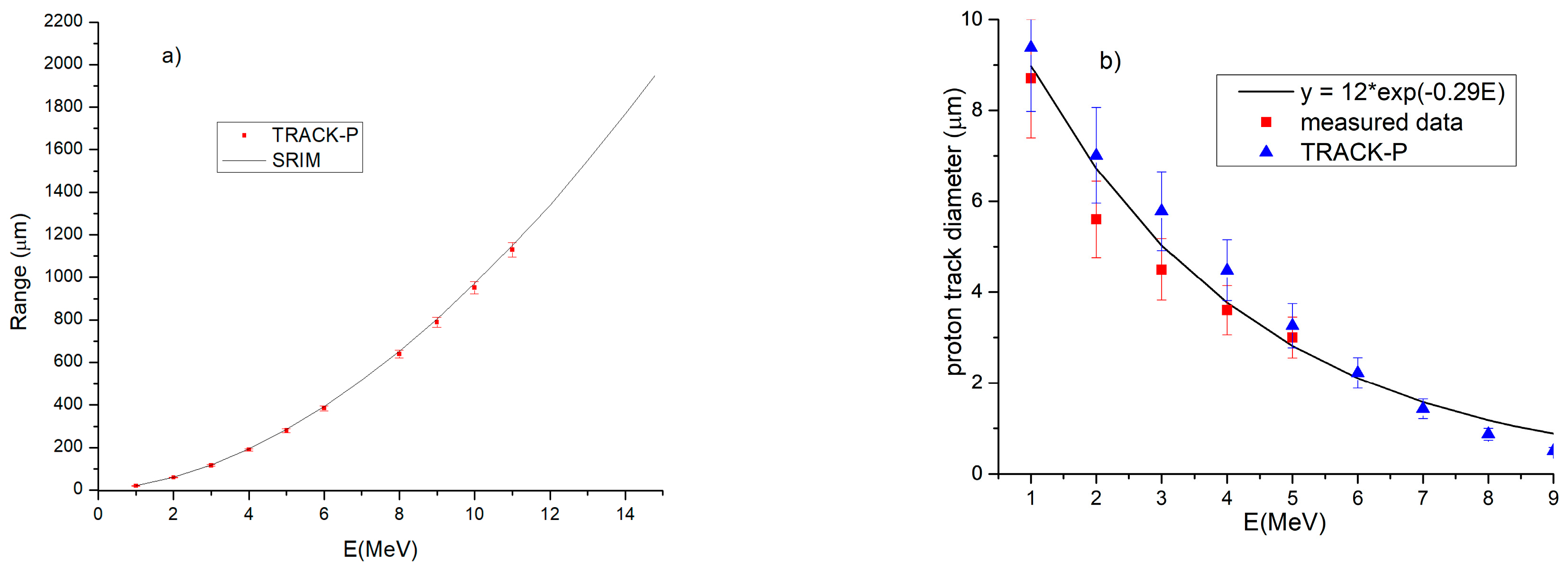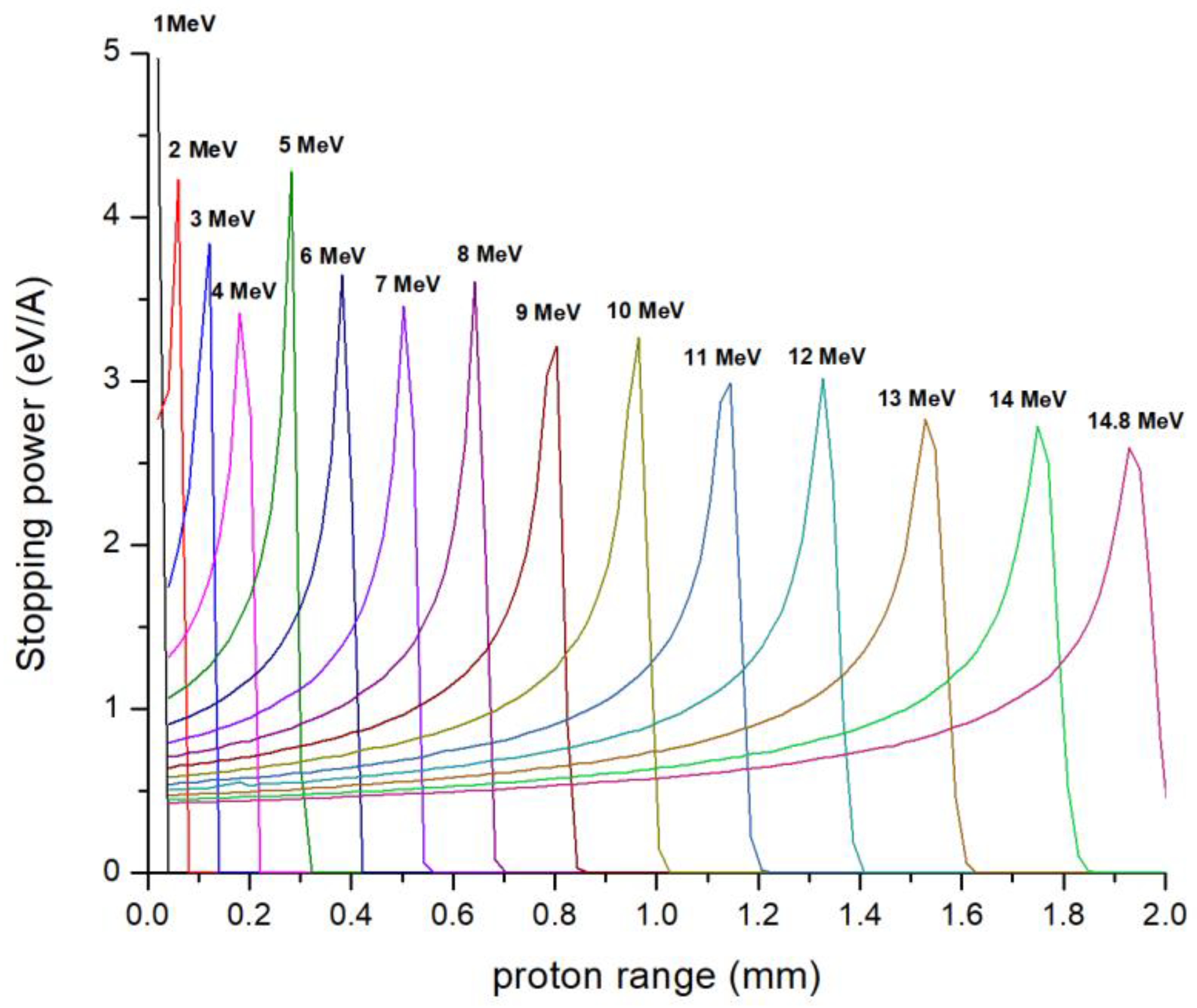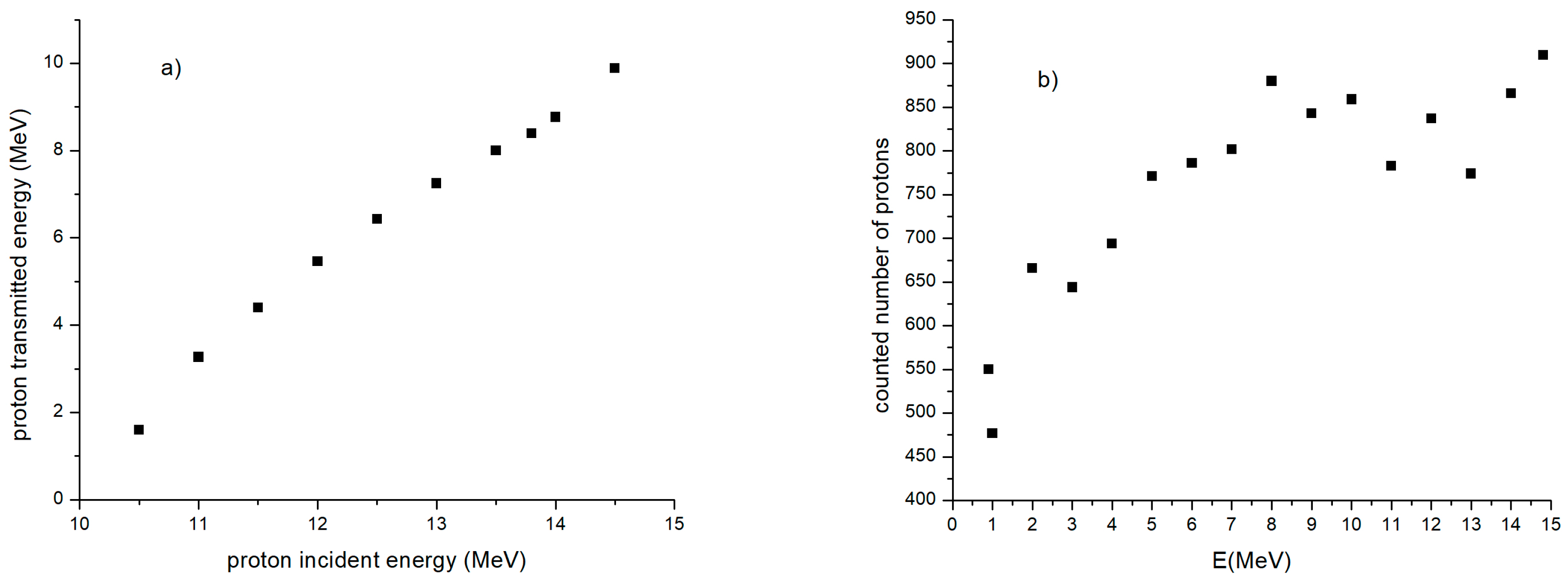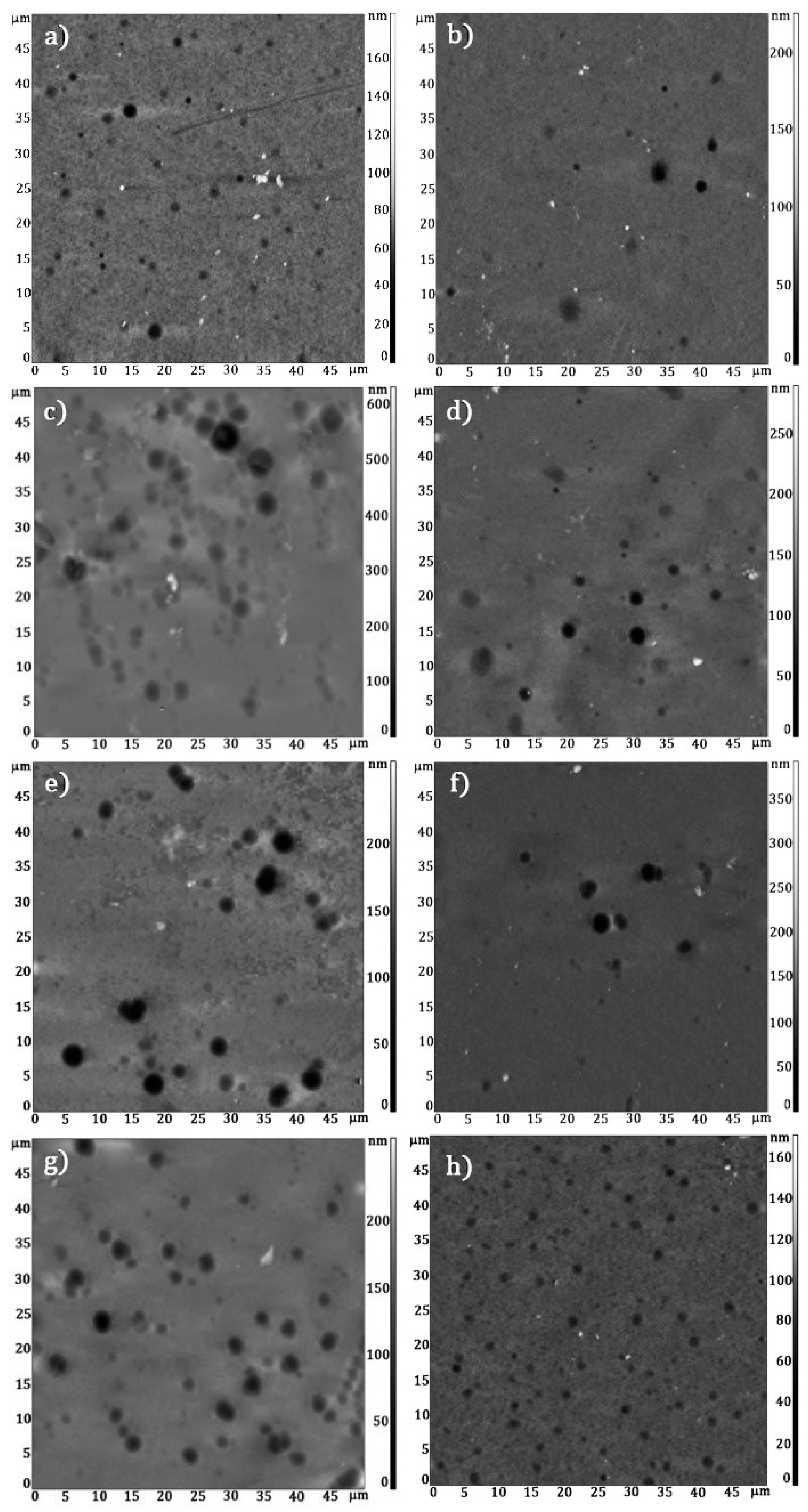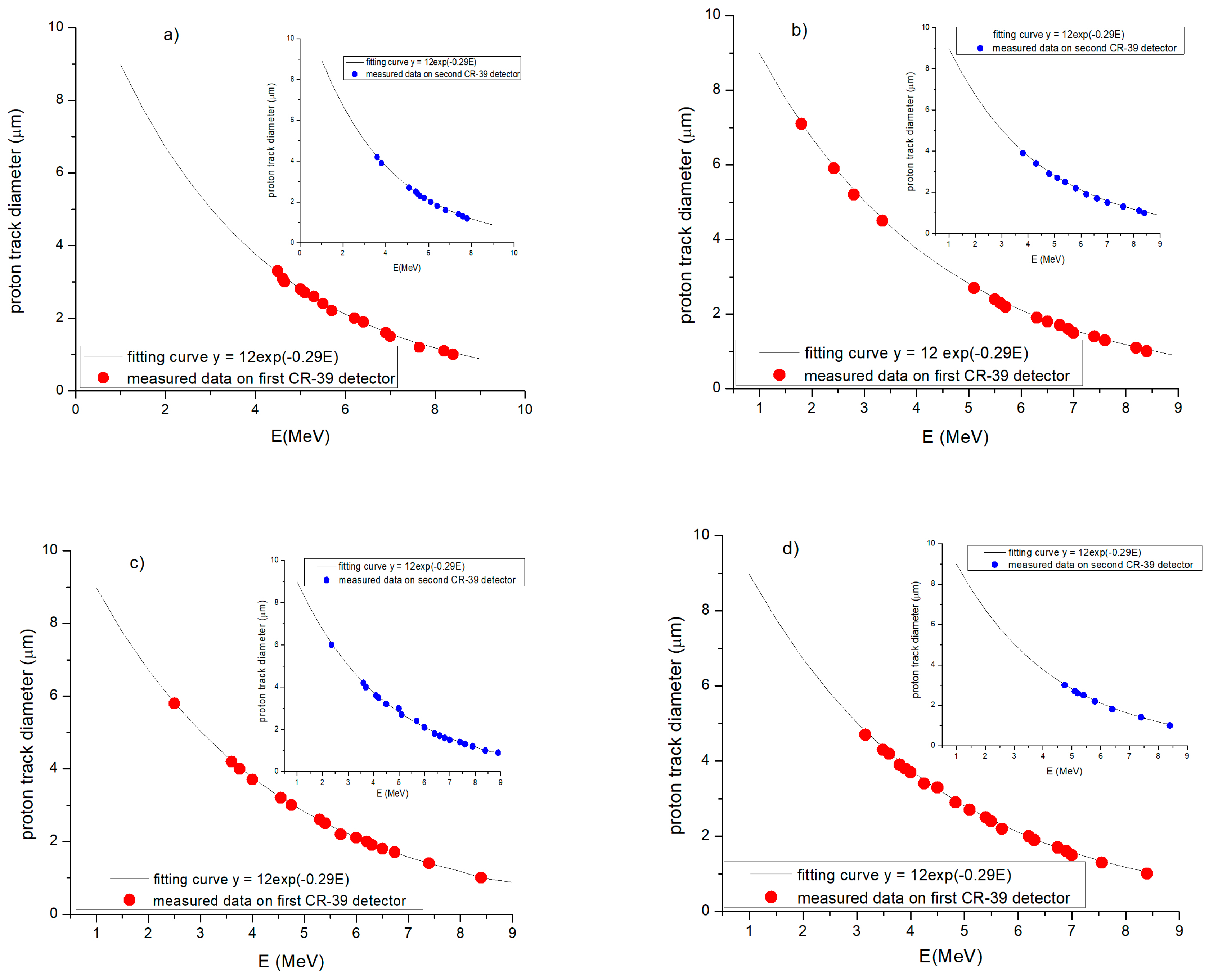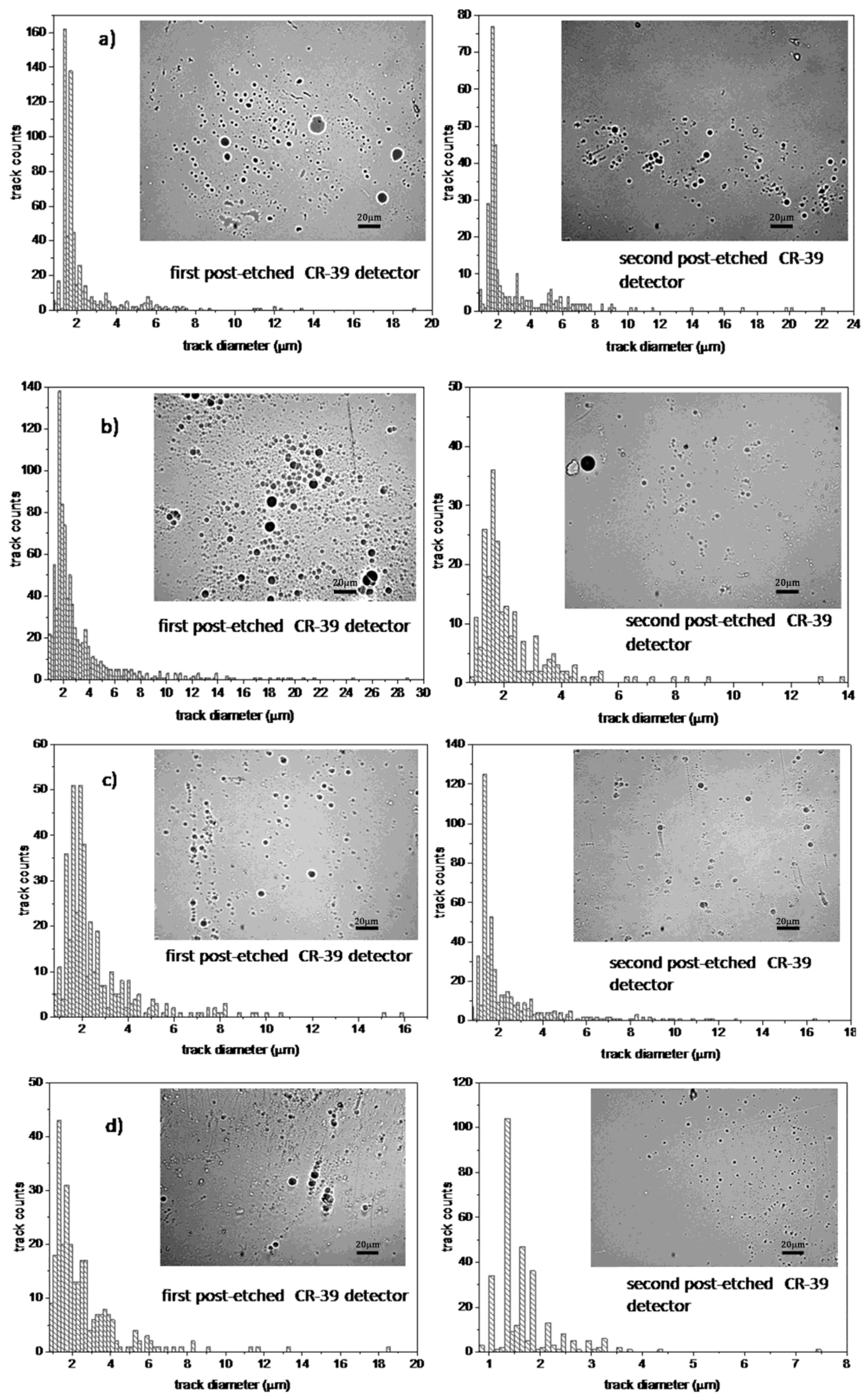3.1. Calibration of CR-39 detectors
The CR-39 nuclear track detectors are frequently used to detect and characterize charged particles such as protons, alpha particles or neutrons [
9,
20]. The analysis of laser-accelerated proton beams by means of CR-39 detectors was demonstrated [
3,
7] to represent a powerful tool, as the shape and size of a track left by each proton into the detector can give useful information about their energy and incident angle.
The region damaged by the protons can be revealed after the chemical etching of the detector. Thus, depending on the etching conditions like: etching solution concentration, etching time and temperature, the proton tracks can be enlarged and made visible through optical microscopy [
7,
9]. The region damaged by protons stopped into the detector is more chemically active than the surrounding protons unaffected zone [
7,
9].
A proton that hits the detector slab at normal incident angle will leave a circular track. An oblique incidence angle between the proton and the detector surface implies an elliptic shape of the track and the major axis will be larger than the minor axis.
The first step in calibrating the CR-39 detectors consists in finding the material bulk etch rate, under very well-defined chemical and temperature conditions. The bulk etch rate of a CR-39 nuclear track detector is usually calculated both experimentally and theoretically. We used the weight loss method to calculate the bulk etch rate experimentally [
21]. Several samples of CR-39 detectors were etched in 6.25 N NaOH solution at 70 °C, for different time intervals. The detector weights were measured before and after etching. Then, the bulk etch rate v
b is determined using the following relation [
21]:
where M
1 represents the initial detector weight, M
2 is the detector weight after chemical etching, while D stands for the initial thickness of the detector, and t is the etching time. The detectors weight was measured using an electronic balance, with a sensitivity of around 10
−4 g. The thickness of each detector was measured by means of an electronic device with an accuracy of 0.01 mm.
Figure 2 shows a graphical representation of equation 1, which results from measurements (red points). By linear fitting (black line) of these experimental data with the analytical function y = ax (a = 1.65), the bulk etch rate of the CR-39 detectors was determined. A bulk etch rate of 1.65 ± 0.05 µm/h over an etching time of 20 h was calculated (see
Figure 2).
Monoenergetic proton beams, produced in the TANDEM accelerator at the Horia Hulubei National Institute for R&D in Physics and Nuclear Engineering (
http://www.nipne.ro), were used to calibrate the CR-39 detectors with an aim to find a relation between the incident energy of the proton beam on a CR-39 detector, and the diameter of the proton tracks revealed after chemical etching. The CR-39 plastic nuclear track detectors were exposed to different proton energies, for beam fluencies of around 70,000 particles/cm
2. The proton beam energy dispersion at the TANDEM facility is ± 5.5 keV. The diameter of the proton beam spot is 7 mm, and the irradiation time value is about 1 s. The particles were normally incident to the surface of the plastic sheet. The particle beam fluency value was specially chosen to avoid overlapping of the proton tracks on the CR-39 detector during the optical microscopy analysis after chemical etching. Reference [
7] shows that proton beams with fluencies in the range of 10
5 particles/cm
2 are suited for counting proton beam tracks by visible light microscopy, avoiding any difficulties owing to track overlapping.
After irradiation, the CR-39 samples were chemically etched using a 6.25 N NaOH solution at 70 °C for 6 hours in an etching bath container under conditions of fine temperature control. The temperature shift during the etching time was about 1 °C. After chemical etching all detectors are washed in distilled water. The diameters of the proton tracks on the post etched CR-39 detectors were analyzed by means of a EUROMEX IS.1053- PLPOLRi polarized microscope (Euromex Microscopen BV, Arnhem, Netherlands), fitted with a CMEX-5000 USB-2 DIGITAL CAMERA -EUROMEX DC.5000 (Euromex Microscopen BV, Arnhem, Netherlands).
Figure 3 show the images of the tracks left by protons within the detector, for proton energies of 2, 3 and 5 MeV. The corresponding measured track diameters of the protons are 5.5 µm, 4.5 µm and 3 µm, respectively. Besides circular proton tracks, in
Figure 3a–c, some traces with irregular shapes and sizes attributed to the chemical etching of the detector material unmarked by protons, can be observed. Similar values for the proton track diameters are obtained after the analysis of the post-etched CR-39 detectors using atomic force microscopy.
The data that connect the proton track diameters with respect to the proton beam energies, are in good agreement with those reported by Malinowska et al. [
8], in case of CR-39 detectors etched in 6.25 N NaOH solution at 70 °C, for different etching times.
Figure 3 from Reference [
8] presents the proton track diameters and the stopping power evolution in CR-39 detectors, as a function of the incident energy and etching time. By extrapolating these data, the proton track diameter values for 6 h etching time are shown to be ~6.8 µm, 5 µm, 4 µm, 3.5 µm and 3 µm, for proton incident energies of 1, 2, 3, 4 and 5 MeV, respectively.
Figure 3 in [
8] also shows that within the 1–6 MeV energy range, the proton track diameter decreases following the evolution of the stopping power as a function of energy.
Recently, Reference [
22] reported on a computer software, TRACK-P, used to compute the proton range and the proton track diameters in a post-etch CR-39 detector, as a function of: the incident proton energy, the bulk etch rate of the detector material, the incident angle of the protons on the detector, and the chemical etching time. It also computes the proton range using the SRIM 2003 software [
23]. For a bulk etch rate of 1.65 µm/h, and proton energies of 1, 2, 3, 4 and 5 MeV, for a 6 h etching time value and a 90° proton incident angle, the proton track diameters computed with TRACK-P are found to be 9.4 µm, 7 µm, 5.7 µm, 4.5 µm and 3.2 µm, respectively. By using the SRIM code of Ziegler et. al. [
23] to calculate the energy loss dE/dx (keV/µm) of protons with energies up to 15 MeV into the detector stack, we find the proton range, as illustrated in
Figure 4a (black line). Protons with energy ranging between 1.1–10.4 MeV are stopped in the first CR-39 detector, while protons with energies between 10.5–14.8 MeV are stopped within the second CR-39 detector.
The proton range can also be computed using the TRACK-P software, but only for 1 mm thick CR-39 detectors and maximum incident proton energy up to 11 MeV [
22]. The results on the proton range calculated with the TRACK-P software using as input data a bulk etch rate of 1.65 µm/h, a 6 h etching time value, and a 90° proton incidence angle on the detector, are presented in
Figure 4a (red points). The percentage errors on the proton range calculated with TRACK-P with respect to SRIM lie within a 3% range.
The proton track diameter evolution as a function of the incident energy for a CR-39 detector, which results from TRACK-P calculations in the 1–9 MeV proton energy range is presented in
Figure 4b (blue triangles). It can be observed that the proton track diameter magnitude decreases from 9.38 µm (for 1 MeV proton energy) to 0.5 µm (for 9 MeV proton energy) as the proton energy increases, presenting a similar behavior with the one reported in [
8], for 1–6 MeV proton energy range.
Figure 4b (red points) illustrates the proton track diameters measured on the post-etched CR-39 detectors after irradiation with monoenergetic proton beams.
A simple analytical function of type y = Aexp(−BE) was used to fit the proton track diameter dependence on energy (see
Figure 4b), where E is the proton energy, and the fitting parameters A, B are indicated in the figure legend. The A and B fitting parameters were iteratively determined using the least-squares fitting procedure in order to assured a minimum percentage error (within ±15%) of the measured proton track values with respect to those calculated with the TRACK-P software.
By calculating the proton track diameter with the analytical function from
Figure 4b, a value of ~9 µm at 1 MeV proton energy results, together with a 0.88 µm track diameter for a proton energy value of 9 MeV.
The proton track diameter dependence on the proton energy shown in
Figure 4b (calculated both experimentally and theoretically) is in good agreement with previous results [
3,
8] for the used etching parameters.
3.2. Estimation of Proton Energies Incident on the Second CR-39 Detector
The proton range and consequently the Bragg peak position for different proton energies within the stack of CR-39 detectors stack was calculated using the SRIM code [
23] (
Figure 4a).
Figure 5 and
Table 1 present the Bragg curves and the Bragg peak position for protons with 1–15 MeV energy range as a function of the incident proton energy. It can be observed that protons with energies higher than 10.5 MeV are fully stopped into the second CR-39 detector, while the first CR-39 detector (1 mm thick) only acts as a filter.
A proton with energy higher than 10.5 MeV could penetrate through 1 mm thick CR-39 detector without losing enough energy to damage it. In [
3] it was showed that protons with energies higher than 10.5 MeV do not leave observable traces on the front side of a 1 mm thick CR-39 detector. Reference [
3] also reports on the presence of tracks for protons with energies higher than 10 MeV (10.5 < E < 10.7 MeV) on the rear side of a first CR-39 detector and on the front side of a second CR-39 detector. A direct correlation between the proton track diameter on the front side of the second detector and the proton energy incident on the detector stack was not established. Previously, [
3,
7,
9,
10] it was reported that the dependence of the proton track diameter on proton incident energy can be established only for protons that stops in a single detector slice (around Bragg peak).
Due to the fact that only protons with energies higher than 10.5 MeV can fully deposit their energies in the second CR-39 detector (the first detector acting as an attenuation energy filter), the correspondence between the proton track diameter identified on the second detector and the incident energy of protons on the second detector can be achieved. Thus, we consider the energy of proton after crossing the first CR-39 detector, as the proton incident energy on the second CR-39 detector.
Table 2 presents the correspondence between the energies of the protons incident on the first detector (with energies higher than 10.5 MeV) and the energies of the protons incident on the second detector, calculated using the Stopping and Range of Ions in Matter (SRIM) code [
23]. The dependence between the energies of the protons transmitted through the first CR-39 detector, and the energies of the protons incident on the detector stack (in 1–15 MeV range) is shown in
Figure 6a. Previously, in [
3,
13] only the transmittance of protons with energies ranging between 10 to 10.7 MeV through 1 mm thick CR-39 detector was analyzed.
The number of protons with energies higher than 10 MeV that travel through a first CR-39 detector and stopped in a second detector can be determined with the SRIM code following a similar calculation procedure with the one used for finding the proton transmitted energy.
The assessment of number of protons with known energy stopped in a slice of CR-39 detector material has also been calculated (see
Figure 6b). Firstly, we estimate the range of protons with energies from 1 to 15 MeV in the 2 mm thick CR-39 detector stack. Then, a CR-39 material slab (2 mm in thick) was sliced in sheaths of different thicknesses. The thickness of each slice was determined by iterative calculations taking into account the proton incident energy and the Bragg peak position into the CR-39 detector slice (see
Table 1). Thus, considering a number of 1000 protons incident on the front side of the detector stack, we calculated the number of protons stopped in each slice of CR-39 detector material as a function of the proton incident energy (see
Figure 6b).
For proton energies ranging from 2 to 15 MeV, the graph presented in
Figure 6b exhibits some discontinuities at 2.2, 5, 8, 10 and respectively, 12 MeV. The SRIM code calculates the number of protons stopped into the CR-39 slab considering its chemical composition (polyallyl-diglycol-carbonate (PADC), C
12H
18O
7) and a value of the detector density of about 1.3 g/cm
3 (given by the Track Analysis System Ltd). So, we suppose that these discontinuities could be specific to the material physical and chemical properties.
3.3. Analysis of the Laser Driven Proton Tracks in CR-39 Detectors by Atomic Force Microscopy (AFM)
The investigation of proton tracks by AFM is more precise with respect to an optical microscopy as it can perform a direct physical measurement of the revealed pits on the post-etched surface of the detector [
23]. However, optical microscopy is currently considered as a standard method to perform the analysis of proton tracks [
3,
8]. The mismatch in the results supplied by these two methods appears mainly because of microscope focusing issues, knowing that the optical image of the CCD camera attached to the microscope consists of a matrix of pixels (with x; y coordinates) and associated grey scale values [
24]. Thus, AFM analysis of the post etched CR-39 detectors can be very useful to identify all questions related to the evidence of proton tracks by optical microscopy, issues that mainly appear due to detector transparency, depth of the proton tracks, and microscope focusing.
Proton beams generated as a result of high-power, laser-thin solid target interaction were identified by AFM, after the tracks left in the post-etched surface of both CR-39 detectors that comprise the irradiated stack (10 µm thick Al foil, 2 CR-39 detectors, each one 1 mm thick). The CR- 39 detectors irradiated with laser driven proton beams were etched for 6 h in 6.25 N NaOH solution at 70 °C.
A SPM-NTegra Prima AFM (NT-MDT) atomic force microscope was used, operating in semi-contact mode with a NSG 01 cantilever (resonance frequency: 87–230 kHz, force constant: 1.45–15.1 N/m). The proton track diameters were also measured using the Image J software.
Figure 7 shows the AFM images of the proton tracks observed on front side of both post etched CR-39 detectors irradiated with laser driven proton beams. The proton tracks mainly exhibit circular shapes of different diameters as an indication of various proton energies of normal incidence on the detector plate. There are no so much elliptic shapes of proton tracks, (which could indicate that the incident angle of the protons on the detector surface is not normal [
3]). The images also point out the influence of the target thickness and material type on the proton number for the 50 × 50 µm
2 investigated area. Similar spatial distributions of the proton tracks on few mm
2 areas were also observed.
The number of proton tracks in the 50 × 50 µm2 area identified on the first detector, in case of high-power laser pulses interaction with Al targets (with 10 and 5 µm thickness), is higher than in case of Ag (with 10 and 5 µm thickness) targets.
The AFM images in
Figure 7 emphasize the presence of proton tracks, with diameters ranging from 1 to 7 µm, on both CR-39 detectors. The circular proton tracks with diameters of ~1 µm are very well illustrated in the AFM images of the post-etched CR-39 detectors, shown in
Figure 7. The differences between the proton track diameters of ~1 µm and the rugged surface of the chemical process detectors (pits of about 0.6 µm) were also revealed. Thus, the uniform distributed tracks with diameters of about 0.6 µm observed on the post–etch surface of the CR-39 detectors, cannot be attributed to protons. On the other hand, as the linear energy transfer (LET) of protons with energy higher than 10.7 MeV is very low in the first CR-39 slab their corresponding track diameters cannot be differentiated from the rugged surface pits.
We suppose that the non-uniform distribution of the proton tracks on the surface of post-etched CR-39 detectors could be attributed to the surface morphology of Al and Ag targets (see
Figure 1d).
The tracks with diameters greater than ~1 µm identified on the surface of the first and second CR-39 detectors (see
Figure 7), irradiated during the performed laser-proton accelerated experiments, present an exponential distribution. The correlation between the proton track diameter and energy was performed by using the fitting curve.
The analytical function y = 12 × exp(−0.29 × E) proposed in
Section 3.1 to establish the proton track diameter dependence on proton energy, was used as a calibration tool to identify (with a percentage error of ±15%) the proton energies read from the AFM images. Using such fitting, a proton track diameter of 1.17 µm correspond to 8 MeV proton energy, while a 0.88 µm diameter corresponds to 9 MeV proton energy. The smallest proton track diameter observed in the AFM images from
Figure 7 is about 1 µm, which indicates proton energies of about 8.4 MeV.
Table 2 indicates that the incident proton energy of 8.4 MeV on the second CR-39 detector corresponds to 13.8 MeV incident proton energy on the detector stack.
The evolution of the proton track diameter on the incident proton energy for both CR-39 detectors, within the 1–9 MeV range, is shown in
Figure 8 together with the fitting curve previously presented in
Figure 4b. As the dependence of the pits identified on the front side of the second CR-39 detector is also an exponential one with respect to energy, result that the measured track diameters can be attributed to protons.
3.4. Analysis of the Laser Driven Proton Tracks in CR-39 Detectors by Visible Light Microscopy
The surfaces of the both front side of the CR-39 post-etched detectors exposed to laser driven proton beams were also investigated by optical microscopy, as the shape and size of the identified tracks were measured, counted and analyzed.
Counting of the track diameters was performed using the Python [
25,
26] wrapper for the OpenCV library [
27], and numerical processing was performed using the NumPy [
28] packages. The first step of this process lies in adjusting the picture contrast for better track edge detection. An algorithm for counting and contour detection was implemented. It uses a simple chain approximation approach which allows performing measurement of the track diameters on the x, y axes. The major and minor axes of the counted tracks were determined. Slight deviations in the values of the major axes relatively to values of the minor axes indicate circular shapes of the tracks. For major differences between the minor and the major axis a correlation with the incident angle of the proton on the detector surface plane can be obtained. A standard deviation of about 1.56 degrees was obtained between the minor and major axes as an indication of a reduced elipticity of the tracks, for all the analyzed CR-39 detectors. This means that the protons incidence angle on the detector varies mainly between 0° (normally incident on the detector surface) and 30° (relative to the normally incident on the detector surface).
Simultaneous measurements of the track diameters were also performed with ImageJ software.
As a result of counting and geometrical shape analysis of protons, the histograms of the minor axes of the track diameters obtained from the acquired optical images of the post-etched CR-39 detectors were plotted (see
Figure 9). The x axis of each graph begins at 0.88 µm, as it represents the minimum number (within ±15% error) of tracks in CR-39 detectors that can be attributed to protons (as seen in
Figure 4b).
The dependence between the proton track diameter (within the 0.88–8 µm range) identified on the front side of each CR-39 detectors and the incident proton energy was established using the calibration curve from
Figure 4b and
Table 2. Thus, the evolution of the tracks counted on the front side of the second CR-39 detector as a function of proton energy was calculated.
In
Figure 10, the spectral distribution of protons stopped in each CR-39 detector after the interaction of the high-power laser pulse with the Al target of 5 µm thickness is presented. It can be observed that the experimental data presented in
Figure 10 are similar with the theoretical predicted one shown in
Figure 6b in the 1–9 MeV energy range. The graphical representation of the counted number of protons stopped in the first and second CR-39 slab (see
Figure 10a,b) present discontinuity points at ~3.3, 5.5 and 6.7 MeV respectively at 4.3, 5.5 and 6.6 MeV. As the revealing of the proton track depends on the etching conditions of the CR-39 detectors, we suppose that these discontinuity points can be linked with the etching process of the detector material as they are slightly different from those identified in
Figure 6b.
Similar results were obtained after the interaction of the high-power laser pulse with the Al and Ag structured targets of 5 and 10 µm thicknesses.
Recently, in [
29] by particle-in-cell simulations of target normal sheath acceleration of protons was obtained a proton spectrum (
Figure 2e from reference) similar with that one from
Figure 10.
Optical images of the proton tracks identified on both front sides of the post-etched CR-39 detectors can be observed in
Figure 8.
These pictures illustrate traces with irregular, circular or elliptic shapes of different sizes that make difficult the proton track analysis. The spots with irregular shapes can be attributed to unwashed contaminants of the etching solution that remain on the detector surface, or to the material etched by the chemical solution. The irregular shapes with dimensions smaller than 0.88 µm (the minimum number of tracks in CR-39 detectors that might be attributed to protons,
Figure 4b) or higher than 8 µm (the maximum number of tracks in CR-39 detectors that might be attributed to protons,
Figure 4b) renders difficult the identification of proton tracks. Only the circular and elliptic shapes observed on the surface of post etched CR-39 detectors with very well-defined edges could be assigned to proton tracks. This is an indication of a good signal to noise ratio and proof of protons.
It may be concluded that for a proper identification of proton track diameters in CR-39 detectors by optical microscopy, it is important to establish, beside a clear signal of proton pits, the theoretically values for the minimum and maximum diameters of the proton tracks.
The non-uniform distribution of the proton tracks on the surface of post-etched CR-39 detectors due to the surface morphology of Al and Ag targets was also observed. Similar proton track distributions were observed for structured dynamic plasma targets [
18].



